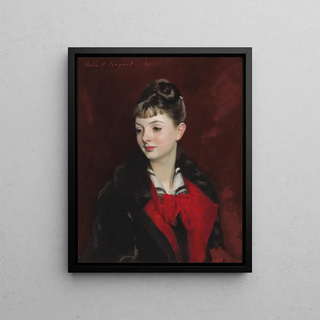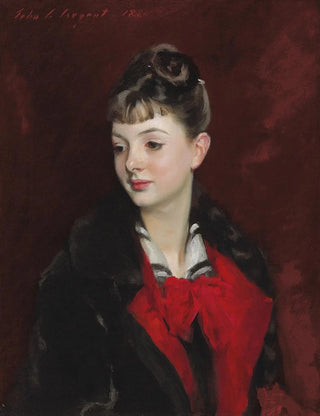Art print | Mademoiselle Suzanne Poirson - John Singer Sargent


View from behind

Frame (optional)
In the fascinating world of art, some works stand out for their ability to capture the very essence of their era. "Mademoiselle Suzanne Poirson" by John Singer Sargent is one of those creations that, through its elegance and depth, continues to enchant art lovers and curious viewers. This painting not only evokes the beauty of a young woman but also immerses the viewer in a timeless dialogue between modernity and tradition. The depiction of Suzanne Poirson, an iconic figure of early 20th-century Parisian art, offers a glimpse into the social and cultural life of her time, while revealing Sargent's technical virtuosity.
Style and uniqueness of the work
Sargent's style is characterized by a bold blend of realism and impressionism, allowing him to create portraits of rare emotional intensity. In "Mademoiselle Suzanne Poirson," light plays a crucial role, illuminating the young woman's face and highlighting the texture of her delicate dress. The brushstrokes, both precise and fluid, give the canvas a lively, almost tangible dynamism. Every detail, from the carefully crafted hairstyle to the subtle nuances of the skin, demonstrates meticulous attention to beauty and harmony. Sargent thus manages to transcend the simple portrait to offer a true character study, revealing the personality and spirit of his model.
The artist and his influence
John Singer Sargent, born in 1856, is often regarded as one of the greatest portraitists of his time. His career, marked by travels across Europe and diverse influences, enabled him to develop a unique style that combines academic tradition with innovation. Sargent captured the elegance of high society while incorporating modern elements that make his works vivid testimonies of their era. His influence extends well beyond his time, inspiring many contemporary and future artists. The way he immortalized his models while conferring upon them an aura of mystery and depth continues to serve as a reference for those aspiring to understand the art of portraiture.

Matte finish

View from behind

Frame (optional)
In the fascinating world of art, some works stand out for their ability to capture the very essence of their era. "Mademoiselle Suzanne Poirson" by John Singer Sargent is one of those creations that, through its elegance and depth, continues to enchant art lovers and curious viewers. This painting not only evokes the beauty of a young woman but also immerses the viewer in a timeless dialogue between modernity and tradition. The depiction of Suzanne Poirson, an iconic figure of early 20th-century Parisian art, offers a glimpse into the social and cultural life of her time, while revealing Sargent's technical virtuosity.
Style and uniqueness of the work
Sargent's style is characterized by a bold blend of realism and impressionism, allowing him to create portraits of rare emotional intensity. In "Mademoiselle Suzanne Poirson," light plays a crucial role, illuminating the young woman's face and highlighting the texture of her delicate dress. The brushstrokes, both precise and fluid, give the canvas a lively, almost tangible dynamism. Every detail, from the carefully crafted hairstyle to the subtle nuances of the skin, demonstrates meticulous attention to beauty and harmony. Sargent thus manages to transcend the simple portrait to offer a true character study, revealing the personality and spirit of his model.
The artist and his influence
John Singer Sargent, born in 1856, is often regarded as one of the greatest portraitists of his time. His career, marked by travels across Europe and diverse influences, enabled him to develop a unique style that combines academic tradition with innovation. Sargent captured the elegance of high society while incorporating modern elements that make his works vivid testimonies of their era. His influence extends well beyond his time, inspiring many contemporary and future artists. The way he immortalized his models while conferring upon them an aura of mystery and depth continues to serve as a reference for those aspiring to understand the art of portraiture.






